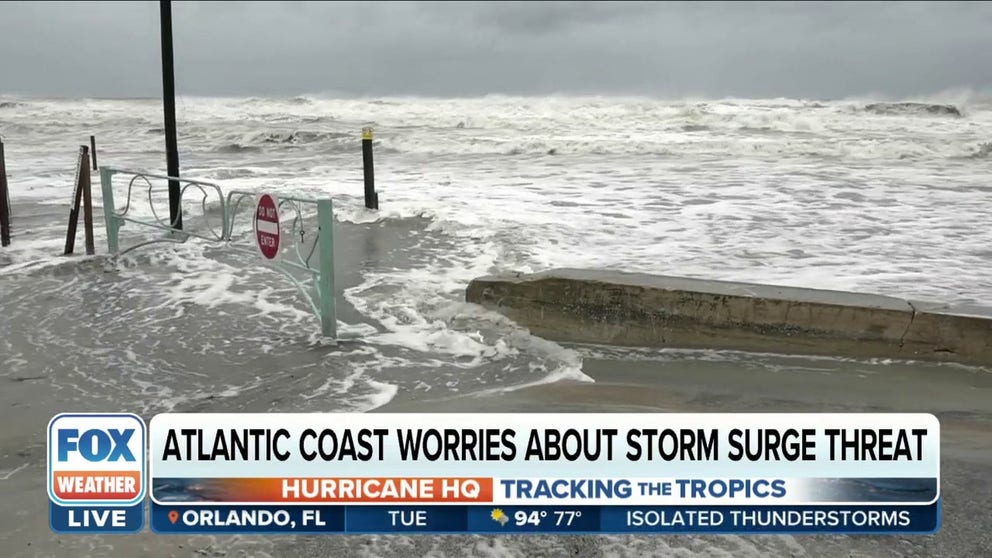Storm surge, rising sea level pose threat to some of America's oldest cities
With every hurricane season, residents in the coastal cities of Charleston and Savannah worry about the threat of storm surges. The Army Corps of Engineers has some plans to keep people safe against the storm.
Storm surge, rising sea level huge threat to coastlines of SC and GA
With every hurricane season, residents in the coastal cities of Charleston and Savannah worry about the threat of storm surges. FOX Weather's Robert Ray spoke with the Army Corps of Engineers about their plans to keep people safe against the storm.
CHARLESTON, S.C. – The peak of hurricane season is quickly approaching, and many people who live in coastal cities worry about the storm surge threat.
Many big plans and challenges are going on to fight surge and sea-level rise in port towns with a lot of history.
Up and down the Atlantic coast, storm surges, pushed in from hurricanes and seas on the rise, are significant challenges, especially for the historic towns with important international ports like Savannah, Georgia.
HOW TO WATCH FOX WEATHER ON TV
"This port is the third-largest port in the nation, and that's only behind New York and L.A.," said Russell Wicke with the U.S. Army Corp of Engineers Savannah District.
And the port of Savannah is also the fastest growing in America; the Savannah River stretches for 40 miles from the Atlantic inland.
"Our job is to do hydrographic surveys every single month to be sure that there are no obstructions for these ships to come in and out," Wicke said.
According to researchers, Savannah could see a foot of sea-level rise by 2045 and a significant increase in tidal flood events – to more than 100 annually.
HOW TO STAY SAFE AFTER A HURRICANE
"And when we are hit by a big storm, there is some risk. The biggest challenge for us is to get out as quickly and efficiently as possible," Wicke said.
And 100 miles to the north is Charleston, South Carolina, where a proposed concrete fortress is meant to keep the city from drowning in a hurricane.
"You don’t plan it now, you literally have to start planning, relocating the city at some point in the future. It’s that critical to our survival."
It’s among the highest-ranking projects for the Army Corps of Engineers. The 8-mile sea wall would stretch around Charleston's peninsula. The estimated cost is around $1.1 billion.
"This is just about mitigating risk," said Lt. Col. Andrew Johannes, the commander of the U.S. Army Corps of Engineers Charleston District. "This is just one piece. It’s also one piece of a larger flooding problem they have here on the peninsula."
The commanding general of the Army Corps of Engineers has asked Congress to fund it, and they have presented a detailed report and environmental analysis. However, the plan awaits congressional approval, which has already passed in the House and is awaiting a vote later this year in the Senate.
Looking back at the Charleston Harbor tide charts, the sea level has risen about a foot over the past 100 years, according to Wes Wilson with the U.S. Army Corps of Engineers Charleston District.
"And we projected out another 50 years, and we projected another foot and a half," Wilson said.
WHAT TO DO WHEN HURRICANE OR TROPICAL STORM WATCHES AND WARNINGS ARE ISSUED FOR YOUR TOWN
Though many people in Charleston, including elected officials, don't think the project is viable.
"This project puts a lot of time, a lot of money, and a lot of resources towards storm surge to the exclusion of rising tides, rising seas, increased stormwater coming out of the sky and issues we have with groundwater management," Charleston Councilman Mike Seekings said. "So, I think it needs to be more integrated."
Mayor John Tecklenburg thinks the project might be the best investment the city will ever make, and the time is now to take action.
"You don’t plan it now, you literally have to start planning, relocating the city at some point in the future. It’s that critical to our survival," Tecklenburg said.
For Charleston's Chief Resiliency officer Dale Morris, integrating others' needs and wants will also be a priority.
7 FACTS TO KNOW ABOUT HURRICANES
"These concerns are legitimate. We respect them. We hear them. We can answer them in the design phase," Morris said. "If we can’t manage them in the design phase, then we won’t build the structure. But we think we can manage them in the design phase with the Army Corps of Engineers and the process that provides to us."
The city is expected to pay around $385 million of the $1.1 billion price tag to build the sea wall if it is approved. The design phase would cost Charleston about $17 million over three to four years.
If Congress approves and if design begins, the wall would likely be about a decade away from being constructed.
